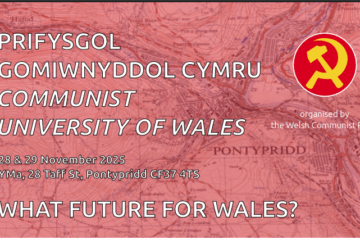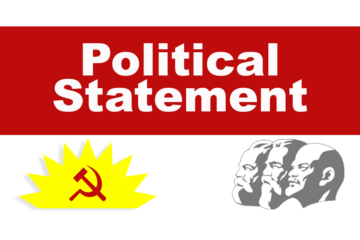A statement from National Platform which is worth reading.
Twenty years ago, in May-June 2005, the people of France and the people of the Netherlands voted No in referendums to the Treaty Establishing a Constitution for Europe. Instead of accepting that result the EU Member State Governments implemented 99% of this EU Constitution through the Treaty of Lisbon four years later, in 2009, but without allowing any referendums on it except in Ireland. When Irish voters rejected the Lisbon Treaty they were made to vote on it again, and it was pushed through without any change. Lisbon established a constitutionally quite new European Union – a supranational Union with its own legal personality for the first time. It gave this new EU the constitutional form of a Federal State and made us all real citizens of this entity, with accompanying citizens’ rights and duties. One can only be a citizen of a State and all States consist of their citizens.
On this 20th anniversary of the French-Dutch votes that led to this constitutional revolution by stealth in the 27 EU countries, it is worth recalling the key facts about it, for they dominate our lives and politics today, even if most people are only vaguely aware of them or their implications.
(1) A War Project, not a Peace Project
The first supranational Community was the European Coal and Steel Community, established by the Treaty of Paris in 1951. This was pushed by the Americans in post-World War II Europe to overcome French concern at rearming Germany as part of NATO to oppose the communist USSR. France was unhappy at the prospect of German rearmament, having been defeated and occupied by Germany just a few years before. The Frenchman Jean Monnet came up with a solution that suited the Americans: put the Coal and Steel industries of Germany and France under joint supranational control, which would prevent either country acting independently. The Schuman Declaration hailed the Coal and Steel Community as “a first step in the federation of Europe”. So the aim of establishing a Federal United States of Europe, similar to the USA but under Franco-German leadership, has been there from the start. The EU celebrates 9 May, the date of this Declaration, as “Europe Day” each year. “Europe must federate or perish,” said US Secretary of State John Foster Dulles at the time. The Americans also pushed the next two supernational communities, the European Economic Community (EEC), established by the 1957 Treaty of Rome, and the European Atomic Energy Community (EURATOM), as providing a European economic leg for the American-led NATO military alliance, whose key purpose was, as its first Secretary-General put it: “to keep Russia out, America in and Germany down”. The legally distinct supranational communities became the European Community in the 1992 Maastricht Treaty.
(2) States Unitary and Federal
In 2025 there are 195 States in the world – most of them unitary States that make all their own laws – and 25 being Federal States in which law-making is divided between a Federal level and a local or regional level, or national level in the case of multinational Federations. All the EU Members were sovereign unitary States before they joined the European Community, except for Germany and Austria which have federal constitutions. They were sovereign in the classic sense that they made all their own laws and had exclusive power to decide independently their relations with other States. Joining the European Community, however, meant that each Member State surrendered important State powers and functions to the supranational Brussels level of the European Community. These supranational powers were added to in a whole series of EC Treaties, all of which required constitutional referendums in Ireland to permit such a surrender: the 1987 Single European Act, the 1992 Maastricht Treaty, the 1998 Amsterdam Treaty, the 2002 Nice Treaty – referendums on which were held twice – and the 2009 Treaty of Lisbon/EU Constitution, on which there were also two referendums.
(3) How the EU Constitution became the Treaty of Lisbon
In 2004 the EC Member State Governments decided to abolish the European Community which had been the repository of supranational European powers up to then and transfer those powers to a constitutionally new European Union that would be endowed with legal personality for the first time and have the constitutional form of a European Federal State. This was the Treaty Establishing a Constitution for Europe. Article 1 of this treaty, which laid down that “…this Constitution establishes the European Union”, showed that such an entity with legal personality had not existed before, although the name “European Union” had been popularised since the 1992 Maastricht Treaty on European Union as referring to the foreign policy and crime and justice areas of the Member States, on which they cooperated “intergovernmentally” rather than supranationally. When French and Dutch voters rejected the Treaty Establishing a Constitution for Europe in referendums in 2005, the EC Member State Governments decided to repackage 99% of its content in the form of amendments to the existing treaties rather than as stand-alone provisions that voters could easily understand. These amendments were set out in the Treaty of Lisbon. Former French President Valéry Giscard d’Estaing, who chaired the convention that drew up the Treaty Establishing a Constitution for Europe, said of the Lisbon Treaty:“All of the earlier proposals will be in the new text but will be hidden or disguised in some way.” And the Member State Governments decided to allow no more popular referendums. These Lisbon amendments gave us the current EU constitutional treaty – formally two Treaties, the Treaty on European Union (TEU) and the Treaty on the Functioning of the European Union (TFEU). Ireland was the only EU country to be allowed a referendum on the Lisbon Treaty/EU Constitution, and when a majority of the Irish electorate voted No to ratifying Lisbon in 2008, the referendum was re-run in 2009 without any change to the Lisbon Treaty, and it was pushed through.
(4) A constitutionally new European Union
The 2009 Lisbon Treaty abolished the European Community which had been the holder of supranational powers up to that time (Art.1 TFEU) and replaced it with a constitutionally new European Union that was endowed with legal personality for the first time also (Art. 47 TEU), although the name “European Union” had been in use for other purposes since 1992. Lisbon gave this new European Union the constitutional character of a Federation, in which State sovereignty is divided between the Federal level of Brussels and the Member State national level, and in which everyone two real citizenships – in the Irish case citizenship of Ireland and citizenship of the post-Lisbon European Union (Art.20 TFEU). Citizens have corresponding rights and duties at each level, just as in such classical Federations as the USA or Germany. One can only be a citizen of a State and all States consist of their citizens. The EU Treaties and EU law based upon them have primacy over the national law of the Member States (Art.244 TFEU, Art.263 TFEU and Declaration No.17 Concerning Primacy). In case of conflict between the rights or duties of citizens on the two levels, the EU level prevails. The EU Court of Justice decides such matters. As real and not just notional citizens of the post-Lisbon European Union, we have the normal citizens’ constitutional duty of defending the EU if it is attacked, and being subject to national conscription if necessary for that purpose. The Triple Lock requirement of a UN Security Council or General Assembly mandate for Irish participation in foreign military operations does, however, at present provide a legal safeguard against the full implementation of this EU citizen requirement for Ireland and Irish citizens in the event of the EU being involved in a future war.
(5) Extending the powers and functions of the post-Lisbon EU
As well as transferring the supranational powers of the European Community to the newly constituted European Union, the Lisbon Treaty put foreign and security policy and crime and justice policy on a supranational basis for the first time. Thus Lisbon brought all areas of public policy within the ambit of the post-Lisbon Union (Arts.23-46 TEU, Arts.2-6 TFEU, Art.67 TFEU). Lisbon also gave the EU’s Court of Justice power to decide our human rights (Art.6 TEU). This last step has great potential for enabling that Court to extend supranational federal powers further by judicial fiat – as US history shows with the American Supreme Court. The word “Constitution” did not appear in the Lisbon Treaty, as that might have alerted people to the fact that Lisbon was the founding treaty of a constitutionally quite new European Union. Lisbon was in effect the Treaty “of” European Union rather than “on” European Union, although that was not explicitly stated – in contrast to the Treaty Establishing a Constitution for Europe that Lisbon was replacing. The only significant provisions of the latter constitutional treaty that were not transferred by the Lisbon Treaty were those providing for the twelve-star EU flag and for making Beethoven’s Hymn to Joy the EU anthem. Mention of these traditional State symbols in the Lisbon Treaty would too readily alert people to the constitutional revolution that was taking place by stealth, without allowing the peoples of the EU Member States a democratic say in referendums. Thus the EU flag and anthem have no EU treaty base to this day, although that has not prevented their widespread use.
(6) An Incomplete Federation: Still no Army or Direct TaxesAlthough endowed with a Federal Constitution, the post-Lisbon EU does not yet have all the features of a fully-fledged State. It does not yet have its own army, and while it is financed by indirect taxes as well as by direct budget contributions from its Member States, it does not impose direct taxes. However, it does not need a new treaty to acquire these key features of full normal statehood. The current EU treaties have provision for them if its Member State Governments unanimously agree. Federal States often take long periods to acquire full statehood – two centuries in the case of the USA, plus a civil war.
(7) Putting EU law-making on a population basis as is normal in States
Having given the post-Lisbon EU a Federal Constitution, the Lisbon Treaty went on to make a major power-political change in the interest of the big Member States. This was to provide that EU law-making henceforth should be based primarily on population size, just as in any normal State. Thus a qualified majority for making EU laws in the Council of Ministers post-Lisbon consists of 55% of the Member States – that is 15 out of 27 – as long as they comprise 65% of the EU’s population of some 450 million. This has had the effect of doubling the relative voting weight of Germany, the EU’s largest country, from its pre-Lisbon level of 8% of the total number of votes on the Council of Ministers to the current 16%. It increased the voting weight of France and Italy from 8% to 12% each, and reduced the voting weight of small countries like Ireland and Denmark from 2% to just under 1% each.
(8) The State Authority of the Post-Lisbon EU
The EU Treaties have shifted power away from citizen voters in all EU countries and from small and middle-sized Member States to the larger ones. The post-Lisbon European Union has its own government, with a legislative, executive and judicial arm, although without the separation of powers that is to be found in normal democratic States. It has its own political President, its own citizens and citizenship, its own human and civil rights code, its own currency, economic policy and revenue, its own international treaty-making powers, foreign policy, foreign minister and diplomatic corps, its own crime and justice code and Public Prosecutor’s Office. The Lisbon Treaty gave the EU a treaty base for the EU army which the EU’s leaders now openly talk about or see it as an EU arm of NATO. From the inside the EU looks like an arrangement between States; from the outside it looks like a State itself.
As regards the “State authority” of the post-Lisbon European Union, this is embodied in the Union’s own executive, legislative and judicial institutions: the Commission, European Council, Council of Ministers, European Parliament and Court of Justice. It is embodied also in the Member States and their authorities as they implement and apply EU law and interpret and apply national law in conformity with Union law. This they are constitutionally required to do by their national Constitutions which have made them members of the EU. Thus EU “State authorities” as represented by EU soldiers and policemen patrolling Europe’s streets in EU uniforms are not needed as such. Their absence makes it all the easier to hide from ordinary citizens the reality of Europe’s hollowed-out Nation States and the catastrophic failure of their own mainstream politicians to defend their national independence and democracy.
The peoples of Europe do not want their independent countries subsumed in an EU Federation, a United States of Europe analogous to the USA, but which in practice would be under the hegemony of Europe’s former imperial powers, in particular Germany and France. That is why Euro-federalism has had to be foisted on Europe’s peoples by stealth from above, by technocratic elites and politicians in the different countries. This was done over decades by means of a series of Treaties that were sold to the various national publics as being necessary and good for jobs, for the economy and for “peace”, but which hollowed out Europe’s Nation States and deprived citizen-voters everywhere of democratic control over most of their laws. Popular reaction against this process is now growing across our continent as people take up the task of re-establishing their national democracy and independence in face of the EU and restoring to their national Parliaments and Government the powers that they have lost.
26 June 2025









